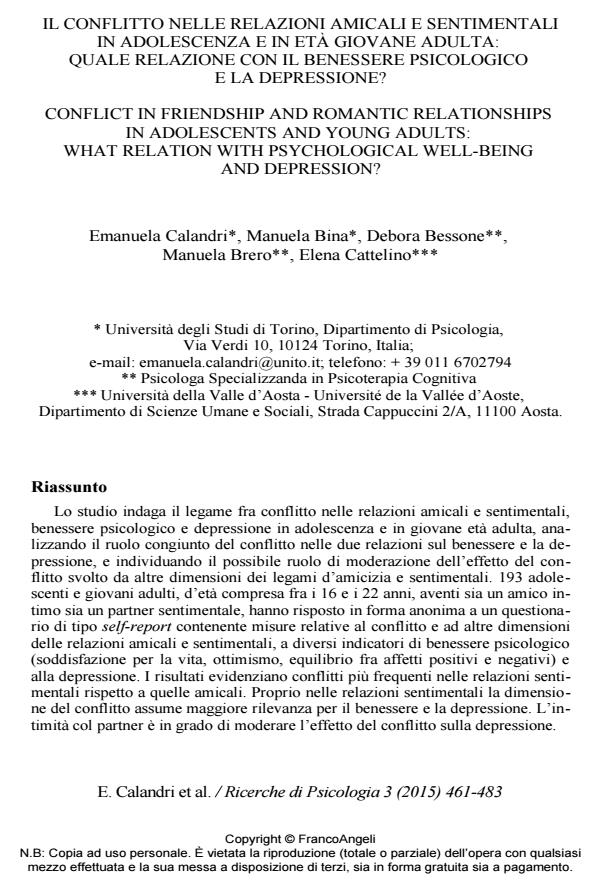Il conflitto nelle relazioni amicali e sentimentali in adolescenza e in età giovane adulta: quale relazione con il benessere psicologico e la depressione?
Titolo Rivista RICERCHE DI PSICOLOGIA
Autori/Curatori Emanuela Calandri, Emanuela Bina, Debora Bessone, Manuela Brero, Elena Cattelino
Anno di pubblicazione 2015 Fascicolo 2015/3
Lingua Italiano Numero pagine 23 P. 461-483 Dimensione file 244 KB
DOI 10.3280/RIP2015-003002
Il DOI è il codice a barre della proprietà intellettuale: per saperne di più
clicca qui
Qui sotto puoi vedere in anteprima la prima pagina di questo articolo.
Se questo articolo ti interessa, lo puoi acquistare (e scaricare in formato pdf) seguendo le facili indicazioni per acquistare il download credit. Acquista Download Credits per scaricare questo Articolo in formato PDF

FrancoAngeli è membro della Publishers International Linking Association, Inc (PILA)associazione indipendente e non profit per facilitare (attraverso i servizi tecnologici implementati da CrossRef.org) l’accesso degli studiosi ai contenuti digitali nelle pubblicazioni professionali e scientifiche
Lo studio indaga il legame fra conflitto nelle relazioni amicali e sentimentali, benessere psicologico e depressione in adolescenza e in giovane età adulta, analizzando il ruolo congiunto del conflitto nelle due relazioni sul benessere e la depressione, e individuando il possibile ruolo di moderazione dell’effetto del conflitto svolto da altre dimensioni dei legami d’amicizia e sentimentali. 193 adolescenti e giovani adulti, d’età compresa fra i 16 e i 22 anni, aventi sia un amico intimo sia un partner sentimentale, hanno risposto in forma anonima a un questionario di tipo self-report contenente misure relative al conflitto e ad altre dimensioni delle relazioni amicali e sentimentali, a diversi indicatori di benessere psicologico (soddisfazione per la vita, ottimismo, equilibrio fra affetti positivi e negativi) e alla depressione. I risultati evidenziano conflitti più frequenti nelle relazioni sentimentali rispetto a quelle amicali. Proprio nelle relazioni sentimentali la dimensione del conflitto assume maggiore rilevanza per il benessere e la depressione. L’intimità col partner è in grado di moderare l’effetto del conflitto sulla depressione
Parole chiave:Conflitto, adolescenza, relazioni intime fra pari, depressione, benessere psicologico
Emanuela Calandri, Emanuela Bina, Debora Bessone, Manuela Brero, Elena Cattelino, Il conflitto nelle relazioni amicali e sentimentali in adolescenza e in età giovane adulta: quale relazione con il benessere psicologico e la depressione? in "RICERCHE DI PSICOLOGIA " 3/2015, pp 461-483, DOI: 10.3280/RIP2015-003002